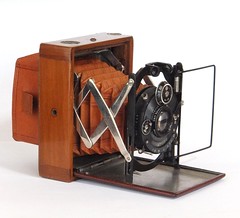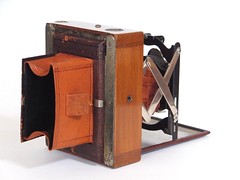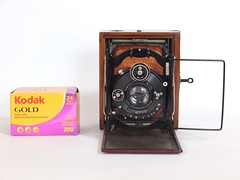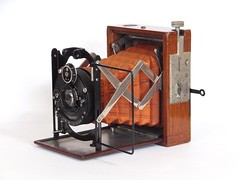Difference between revisions of "Sonnet"
(stub) |
m (Updated LPA links) |
||
| (12 intermediate revisions by 2 users not shown) | |||
| Line 1: | Line 1: | ||
| − | {{stub}} | + | {{stub}}{{Flickr_image |
| − | The '''Sonnet''' is a range of strut-folding plate cameras made by [[Nettel|Nettel Camerawerk]] from about 1908, and later by [[Contessa-Nettel]].<ref name=McK>{{McKeown12}} p715 (Nettel) | + | |image_source= http://www.flickr.com/photos/32582084@N06/8836317021/in/pool-camerawiki/ |
| + | |image= http://farm6.staticflickr.com/5463/8836317021_f2c97340d5_n.jpg | ||
| + | |image_align= right | ||
| + | |image_text= Tropen Sonnet 4,5x6cm | ||
| + | |image_by= yalluflex | ||
| + | |image_rights= with permission | ||
| + | }} | ||
| + | The '''Sonnet''' is a range of strut-folding plate cameras made by [[Nettel|Nettel Camerawerk]] from about 1908, and later by [[Contessa-Nettel]] and [[Zeiss Ikon]] until about 1930.<ref name=McK>{{McKeown12}} p715 (Nettel), 216 (Contessa-Nettel) and 1058 (Zeiss Ikon).</ref> It is a wooden-bodied vertical folder, similar to the metal-bodied [[Kibitz]]. Both cameras might be seen as poor cousins to the [[Nettel]] strut-folders with focal-plane shutters. The Sonnet has a simple metal folding bed and a metal lens standard which runs out on this bed, positioned by pantograph struts (i.e. scissor-struts with a hinge half-way along). As in the Nettel cameras, the strut extension is adjustable with a focusing knob on the camera body, giving a focus control, and in some examples, the end of one of the struts acts as the pointer on a focus scale on the body. In addition, the camera can be focused using a ground-glass screen. | ||
| − | Unlike the Nettel cameras, the Sonnet has | + | Unlike the Nettel cameras, the Sonnet has a dial-set [[Ibso]], [[Compound]] or later [[Compur]] in-lens shutter rather than a focal-plane one, offering a much smaller (and slower) range of speeds. Available lenses included Nettel's own Anastigmats and Rapid Aplanats, Goerz Dagors and Carl Zeiss Tessars.<ref name=McK /> McKeown notes that cameras sold in France often had French lenses (by [[Berthiot]]), and ''Early Cameras'' shows an example with an (English) Cooke Anastigmat.<ref name=EP>[http://www.earlyphotography.co.uk/site/entry_C269.html 6.5x9 Tropical Sonnet], about 1915 (from lens serial number), with 4-inch f/4.5 Cooke Series-II Anastigmat and Compur shutter, at [http://www.earlyphotography.co.uk/index.html Early Photography].</ref> |
| − | The Sonnet was made in several sizes: 4.5x6 cm, 6.5x9 cm, 9x12 cm and 10x15 cm. Standard black and tropical models were made. | + | The Sonnet was made in several sizes: 4.5x6 cm,<ref>[https://www.leitz-auction.com/en/Nettel-Kamerawerk-Tropen-Sonnet/AI-6-24037 4.5x6 cm Tropical Sonnet by Nettel Camerawerk], about 1915, with 7.5 cm f/4.5 Tessar and Compound shutter, sold at the [https://www.leitz-auction.com/en/Cameras/Past-Auctions/Auction-6/ sixth Westlicht Photographica Auction], on 6 November 2004.</ref> 6.5x9 cm,<ref name=EP /><ref>[https://www.leitz-auction.com/en/Contessa-Nettel-Sonnet-Tropical/AI-21-13646 6.5x9 cm Tropical Sonnet by Contessa-Nettel] serial no. 589565, about 1920, with 12 cm f/4.5 Tessar and Compur shutter, and both frame and brilliant finders, sold at the [https://www.leitz-auction.com/en/Cameras/Past-Auctions/Auction-21/ 21st Westlicht auction], on 23 May 2012.</ref> 9x12 cm and 10x15 cm. Standard black and tropical models were made; notes at Pacific Rim Camera suggest that only the two smaller sizes were continued by Zeiss Ikon, and that these were only made in tropical finish.<ref name=PRC>[http://www.pacificrimcamera.com/pp/zisonnet.htm Notes on the Sonnet], with a picture of a 6.5x9 cm Contessa-Nettel example, at [http://www.pacificrimcamera.com/pp/rindex.htm Pacific Rim Camera's Photographica pages].</ref> In fact, most examples seen of the camera of any age are tropical; this may be because these command higher prices and so are more likely to appear at auctioneers. |
| + | |||
| + | Most examples have a wire frame finder, with the wire frame hinged on the front standard, and a folding eye-pointer on the body. Some also have a brilliant finder. McKeown shows examples (one under Nettel and one under Contessa-Nettel) with a folding [[Viewfinder#Newton finder|Newton finder]] on the body instead of the frame finder.<ref name=McK /> | ||
| + | |||
| + | {| class="plainlinks" align="center" style="text-align: center;" | ||
| + | | [http://www.flickr.com/photos/32582084@N06/8836945604/in/pool-camerawiki/ http://farm6.staticflickr.com/5336/8836945604_f9173f3743_m.jpg] [http://www.flickr.com/photos/32582084@N06/8836309055/in/pool-camerawiki/ http://farm4.staticflickr.com/3783/8836309055_e07aa0a23f_m.jpg] [http://www.flickr.com/photos/32582084@N06/8836932852/in/pool-camerawiki/ http://farm4.staticflickr.com/3674/8836932852_9f8c948a31_m.jpg] | ||
| + | |- | ||
| + | | [http://www.flickr.com/photos/32582084@N06/8836929276/in/pool-camerawiki/ http://farm3.staticflickr.com/2840/8836929276_a313cf248a_m.jpg] [http://www.flickr.com/photos/32582084@N06/8836938552/in/pool-camerawiki/ http://farm8.staticflickr.com/7307/8836938552_141338b27e_m.jpg] | ||
| + | |- | ||
| + | |Tropen Sonnet 4,5x6cm, Carl Zeiss Jena Tessar f4,5/7,5cm.<br><small>Images by {{image author|yalluflex}}. </small>{{with permission}} | ||
| + | |} | ||
| Line 14: | Line 31: | ||
[[Category: Nettel]] | [[Category: Nettel]] | ||
[[Category: Contessa-Nettel]] | [[Category: Contessa-Nettel]] | ||
| + | [[Category: Zeiss Ikon]] | ||
[[Category: 1906-1910]] | [[Category: 1906-1910]] | ||
[[Category: 4.5x6 plate strut folding]] | [[Category: 4.5x6 plate strut folding]] | ||
| Line 19: | Line 37: | ||
[[Category: 9x12 strut folding]] | [[Category: 9x12 strut folding]] | ||
[[Category: German 10x15]] | [[Category: German 10x15]] | ||
| + | [[Category: S]] | ||
Latest revision as of 17:50, 23 January 2024

|
| Tropen Sonnet 4,5x6cm image by yalluflex (Image rights) |
The Sonnet is a range of strut-folding plate cameras made by Nettel Camerawerk from about 1908, and later by Contessa-Nettel and Zeiss Ikon until about 1930.[1] It is a wooden-bodied vertical folder, similar to the metal-bodied Kibitz. Both cameras might be seen as poor cousins to the Nettel strut-folders with focal-plane shutters. The Sonnet has a simple metal folding bed and a metal lens standard which runs out on this bed, positioned by pantograph struts (i.e. scissor-struts with a hinge half-way along). As in the Nettel cameras, the strut extension is adjustable with a focusing knob on the camera body, giving a focus control, and in some examples, the end of one of the struts acts as the pointer on a focus scale on the body. In addition, the camera can be focused using a ground-glass screen.
Unlike the Nettel cameras, the Sonnet has a dial-set Ibso, Compound or later Compur in-lens shutter rather than a focal-plane one, offering a much smaller (and slower) range of speeds. Available lenses included Nettel's own Anastigmats and Rapid Aplanats, Goerz Dagors and Carl Zeiss Tessars.[1] McKeown notes that cameras sold in France often had French lenses (by Berthiot), and Early Cameras shows an example with an (English) Cooke Anastigmat.[2]
The Sonnet was made in several sizes: 4.5x6 cm,[3] 6.5x9 cm,[2][4] 9x12 cm and 10x15 cm. Standard black and tropical models were made; notes at Pacific Rim Camera suggest that only the two smaller sizes were continued by Zeiss Ikon, and that these were only made in tropical finish.[5] In fact, most examples seen of the camera of any age are tropical; this may be because these command higher prices and so are more likely to appear at auctioneers.
Most examples have a wire frame finder, with the wire frame hinged on the front standard, and a folding eye-pointer on the body. Some also have a brilliant finder. McKeown shows examples (one under Nettel and one under Contessa-Nettel) with a folding Newton finder on the body instead of the frame finder.[1]
  
|
 
|
| Tropen Sonnet 4,5x6cm, Carl Zeiss Jena Tessar f4,5/7,5cm. Images by yalluflex. (Image rights) |
Notes
- ↑ 1.0 1.1 1.2 McKeown, James M. and Joan C. McKeown's Price Guide to Antique and Classic Cameras, 12th Edition, 2005-2006. USA, Centennial Photo Service, 2004. ISBN 0-931838-40-1 (hardcover). ISBN 0-931838-41-X (softcover). p715 (Nettel), 216 (Contessa-Nettel) and 1058 (Zeiss Ikon).
- ↑ 2.0 2.1 6.5x9 Tropical Sonnet, about 1915 (from lens serial number), with 4-inch f/4.5 Cooke Series-II Anastigmat and Compur shutter, at Early Photography.
- ↑ 4.5x6 cm Tropical Sonnet by Nettel Camerawerk, about 1915, with 7.5 cm f/4.5 Tessar and Compound shutter, sold at the sixth Westlicht Photographica Auction, on 6 November 2004.
- ↑ 6.5x9 cm Tropical Sonnet by Contessa-Nettel serial no. 589565, about 1920, with 12 cm f/4.5 Tessar and Compur shutter, and both frame and brilliant finders, sold at the 21st Westlicht auction, on 23 May 2012.
- ↑ Notes on the Sonnet, with a picture of a 6.5x9 cm Contessa-Nettel example, at Pacific Rim Camera's Photographica pages.